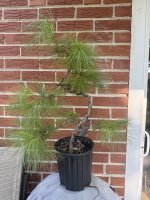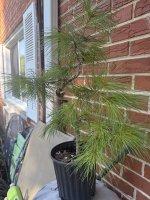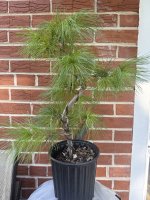raumtraum
Seed
Hi,
I've been lurking for a bit here and there, mainly catching up on the wealth of knowledge this forum has produced. I'm new to bonsai, and I have three trees: an Azalea from nursery stock, a Juniper I bought from Stone Lantern, and a Eastern White Pine I received from a good friend. I am located in the NW Chicago Burbs, and my previous plant experience mainly rests on philodendrons and various houseplants, as well as some cacti.
Naturally, I am reaching out for design advice on the Eastern White Pine (I know that many consider it a sub-standard material, but I do love a challenge). I am aware I need to re-wire it soon, as the current wiring is beginning to scare the branches. But I am completely lost on how to approach design for this specimen. I hope one of ya'll has some good insight for me .
.
I did see that I have some local resources I could also use: I see The Hidden Gardens Bonsai & Mark Karczewski offer evaluations every Saturday, and I see that the next Midwest Bonsai Society meeting is hosting Phil Mahliot to discuss difficult trees. I might do one or both events to gain some additional guidance and in-person feedback.
Any tips for EWP care are also appreciated!
I've been lurking for a bit here and there, mainly catching up on the wealth of knowledge this forum has produced. I'm new to bonsai, and I have three trees: an Azalea from nursery stock, a Juniper I bought from Stone Lantern, and a Eastern White Pine I received from a good friend. I am located in the NW Chicago Burbs, and my previous plant experience mainly rests on philodendrons and various houseplants, as well as some cacti.
Naturally, I am reaching out for design advice on the Eastern White Pine (I know that many consider it a sub-standard material, but I do love a challenge). I am aware I need to re-wire it soon, as the current wiring is beginning to scare the branches. But I am completely lost on how to approach design for this specimen. I hope one of ya'll has some good insight for me
I did see that I have some local resources I could also use: I see The Hidden Gardens Bonsai & Mark Karczewski offer evaluations every Saturday, and I see that the next Midwest Bonsai Society meeting is hosting Phil Mahliot to discuss difficult trees. I might do one or both events to gain some additional guidance and in-person feedback.
Any tips for EWP care are also appreciated!







